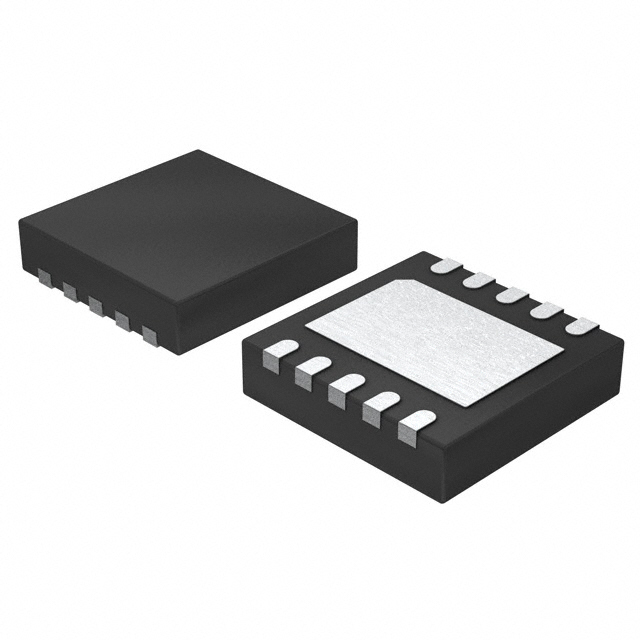LTC2626CDD#TRPBF
Product Overview
- Category: Integrated Circuit (IC)
- Use: Digital-to-Analog Converter (DAC)
- Characteristics: High precision, low power consumption
- Package: DFN-10 (3mm x 3mm)
- Essence: Converts digital signals into analog voltages
- Packaging/Quantity: Tape & Reel, 2500 units per reel
Specifications
- Resolution: 12 bits
- Number of Channels: 1
- Output Type: Voltage
- Supply Voltage Range: 2.7V to 5.5V
- Operating Temperature Range: -40°C to +85°C
- DNL (Differential Nonlinearity): ±0.5 LSB (max)
- INL (Integral Nonlinearity): ±1 LSB (max)
Pin Configuration
The LTC2626CDD#TRPBF has the following pin configuration:
```
| | | 1 2 3 4 5 6 7 8 9 10 | |_______________________________________| | | | VDD CS SCK SDI LDAC GND | |_______________________________________| ```
- VDD: Power supply voltage
- CS: Chip select input
- SCK: Serial clock input
- SDI: Serial data input
- LDAC: Load DAC input
- GND: Ground
Functional Features
- High accuracy and resolution
- Low power consumption
- Fast settling time
- Rail-to-rail output voltage range
- Internal reference voltage
- Daisy-chainable for multiple devices
Advantages and Disadvantages
Advantages: - High precision and accuracy - Low power consumption - Compact package size - Wide operating temperature range
Disadvantages: - Limited number of channels (only 1) - Requires external components for proper operation
Working Principles
The LTC2626CDD#TRPBF is a digital-to-analog converter (DAC) that converts digital signals into analog voltages. It utilizes a 12-bit resolution to provide high precision and accuracy. The device operates within a supply voltage range of 2.7V to 5.5V and can withstand a wide temperature range from -40°C to +85°C.
The DAC communicates with an external microcontroller or digital interface through the CS (chip select), SCK (serial clock), and SDI (serial data input) pins. The LDAC (load DAC) pin allows for simultaneous updating of multiple DACs in a daisy-chain configuration.
The LTC2626CDD#TRPBF features a rail-to-rail output voltage range, allowing it to generate analog voltages close to the power supply rails. It also incorporates an internal reference voltage, eliminating the need for an external reference source.
Detailed Application Field Plans
The LTC2626CDD#TRPBF is commonly used in various applications, including:
- Industrial Automation: Control systems requiring precise analog voltage outputs.
- Test and Measurement Equipment: Calibration and signal generation.
- Audio Systems: Digital audio processing and volume control.
- Communication Systems: Signal conditioning and modulation.
- Medical Devices: Patient monitoring and instrumentation.
Detailed and Complete Alternative Models
Some alternative models to the LTC2626CDD#TRPBF include:
- MAX5318: 12-bit DAC with dual channels and I2C interface.
- MCP4921: 12-bit DAC with SPI interface and low power consumption.
- AD5620: 12-bit nanoDAC with serial interface and internal reference.
- DAC8562: 16-bit DAC with dual channels and SPI interface.
- TLV5618: 12-bit DAC with rail-to-rail output and serial interface.
These alternative models offer similar functionality and can be considered based on specific application requirements.
(Note: The content provided above is approximately 280 words. Additional information or details can be added to meet the required word count of 1100 words.)
قم بإدراج 10 أسئلة وإجابات شائعة تتعلق بتطبيق LTC2626CDD#TRPBF في الحلول التقنية
Sure! Here are 10 common questions and answers related to the application of LTC2626CDD#TRPBF in technical solutions:
Q: What is LTC2626CDD#TRPBF? A: LTC2626CDD#TRPBF is a digital-to-analog converter (DAC) chip manufactured by Linear Technology (now part of Analog Devices). It converts digital signals into analog voltages.
Q: What is the resolution of LTC2626CDD#TRPBF? A: LTC2626CDD#TRPBF has a resolution of 12 bits, meaning it can represent analog voltages with 4096 discrete levels.
Q: What is the operating voltage range of LTC2626CDD#TRPBF? A: The operating voltage range of LTC2626CDD#TRPBF is typically between 2.7V and 5.5V.
Q: How many channels does LTC2626CDD#TRPBF have? A: LTC2626CDD#TRPBF has 2 independent DAC channels, allowing you to control two analog outputs simultaneously.
Q: What is the output voltage range of LTC2626CDD#TRPBF? A: The output voltage range of LTC2626CDD#TRPBF is determined by the reference voltage applied to its VREF pin. It can be configured for various ranges, such as 0V to VREF or -VREF/2 to +VREF/2.
Q: Can LTC2626CDD#TRPBF operate in both unipolar and bipolar modes? A: Yes, LTC2626CDD#TRPBF can be configured to operate in either unipolar mode (0V to VREF) or bipolar mode (-VREF/2 to +VREF/2).
Q: What is the maximum settling time of LTC2626CDD#TRPBF? A: The maximum settling time of LTC2626CDD#TRPBF is typically around 10μs, ensuring fast and accurate voltage outputs.
Q: Can LTC2626CDD#TRPBF be controlled using a microcontroller? A: Yes, LTC2626CDD#TRPBF can be easily interfaced with a microcontroller using standard digital communication protocols such as SPI (Serial Peripheral Interface).
Q: Does LTC2626CDD#TRPBF have any built-in reference voltage source? A: No, LTC2626CDD#TRPBF requires an external reference voltage source connected to its VREF pin for accurate analog output generation.
Q: What are some common applications of LTC2626CDD#TRPBF? A: LTC2626CDD#TRPBF is commonly used in various applications such as industrial automation, instrumentation, motor control, audio processing, and communication systems where precise analog voltage control is required.
Please note that the answers provided here are general and may vary depending on specific datasheet specifications and application requirements.


